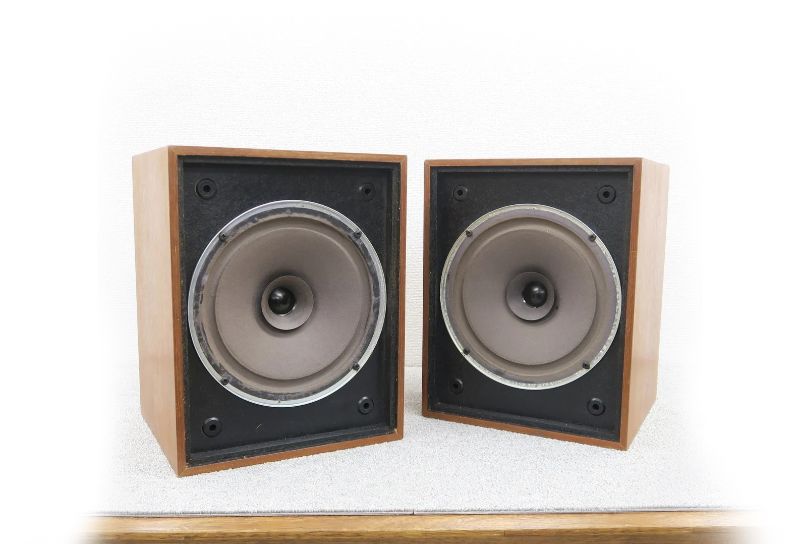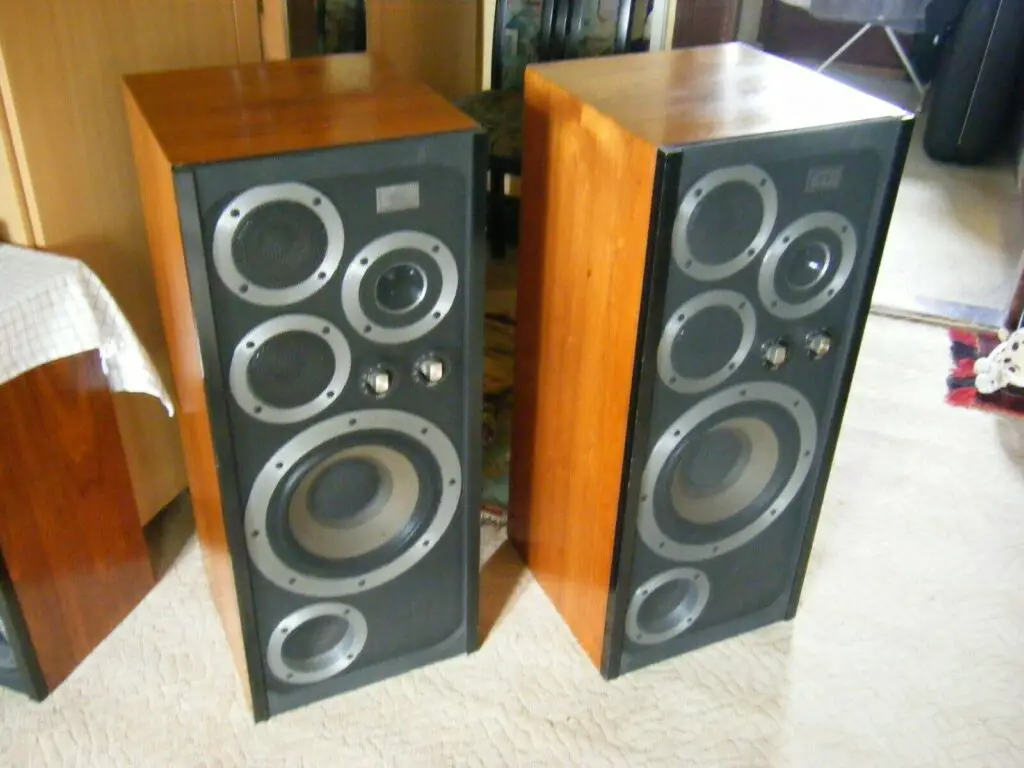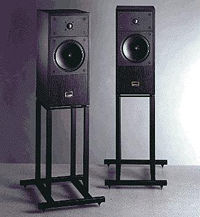The £3,295 ATC SCM40 is unusual in that it doesn’t look or feel like practically any other loudspeaker in its price range. It’s almost as if someone forgot to style it, as if three (albeit unusual-looking) drivers were thrown into a box supposed to do the job and then left. This stands in stark contrast to many competitors, who use a variety of artistic flourishes. Despite looking rather ‘old school’ – albeit in a pleasantly timeless sort of way – the SCM40 is actually a new model which came out in 2013, replacing a 2007 design of the same name that looked as if it has been launched in 1988! It appears that ATC isn’t very concerned about fashion…
The quality of the construction, on the other hand, is another story. There is nothing about this speaker which suggests it is built to its price, and you’re reminded of this when you try to move it – at 31kg a pop. Closer inspection reveals the drive units to be archaic, which they are — particularly the midband. The Gloucester firm began by manufacturing drive units for professional monitor speakers before branching out on its own. Billy Woodman, founder of ATC, seems as fascinated by transducers now as he was forty years ago when the company was born, and the SCM40 has a dome mid unit unique to this marque.
Because they’re difficult to produce correctly, only a few businesses make intermediate domes these days. To accommodate these frequencies, most people prefer to utilize a tiny version of a coned bass driver. Along with great dispersion, a dome has the advantage of being phase-coherent with the dome tweeter, which means it radiates sound waves in a comparable manner. This improves the interaction between the tweeter and the midrange driver, and you can hear it in every speaker made in this way, from the vintage Yamaha NS1000M to the SCM40. A hand-doped acrylic diaphragm and suspension mechanism, as well as a “secret ATC recipe,” are used in this 75mm soft dome mid speaker. It connects to a 25mm dome tweeter with a doped polyester diaphragm and suspension, as well as an alloy wave guide, designed and constructed by ATC. The bass driver is 164mm in diameter and features a hand coated paper pulp diaphragm, chosen for its balance of low mass, damping and rigidity, and there’s a huge motor assembly behind.
A three-element crossover with a low pass filter, band pass filter, and high pass filter is installed. The efficiency of the system is set by the bass driver with the mid and HF padded down accordingly, the company says, so it’s kept as simple as possible – this is achievable because the drivers are designed around it. The crossover points are 380Hz and 3.5kHz, like with other ATC three-ways. One issue with this speaker is that it is difficult to use. According to ATC, the amplifier’s impedance curve is flat, so it shouldn’t require Herculean current reserves, but it does require watts! The quoted sensitivity for a huge box is low — 85dB/1w/1m – implying that more than 60W is required. At very high volumes, I tried various solid-state amplifiers (no valves required), and they all got hot and little disturbed. This is due in part to ATC’s decision to employ an endless baffle cabinet, which necessitates more from whatever is powering it.
There are far too many loudspeakers that wishfully describe themselves as “studio monitors,” but we have something that comes much closer to this than most. This big (265x980x300mm floorstander is unerringly revealing of what you put into it, and certainly doesn’t sugar the pill. But, if you believe it’s cerebral, analytical, and dispassionately forensic, you’re wrong. You get a surprisingly fine sound if you feed it a high-quality source through a smooth, powerful solid-state amplifier.
In essence, you get a big, wideband sound that’s crisper and more open than anything else I’ve heard at this price point. This is emphasized by its excellent bass; debates abound over the relative benefits of infinite baffle boxes, but ATC has nailed it with this one. The only disadvantage is that it makes less powerful amplifiers sound like a jogger wearing concrete footwear! For example, Kraftwerk’s Tour de France Soundtracks was breathtaking – rarely have I heard this album’s low frequencies in such sharp relief.
Positioned 30cm from my back wall and slightly toed in, the speed, power, and grip were exceptional – it easily outperformed more expensive big boxes like Spendor’s D7 or Sonus faber’s Olympica II. The synth bass’s assault transients were incredible, starting and stopping at the pace of an LED. On songs with vast tracts of low frequencies such the Moog bass on 4hero’s Cosmic Tree, the bottom end is rock-solid, prodigious and ultra tight, but give it an indie guitar track like REM’s Maps and Legends and the speaker is relatively circumspect, refusing to over-egg the pudding so to speak. It basically informs you what’s going on if it’s going on, and it doesn’t if it isn’t. This is the mark of a serious wideband monitor loudspeaker, and it serves as a reminder that many reflex ported designs nowadays simply don’t do bass well.
Not so the SCM40, and the way it integrates its superb low frequencies with the midband is a joy; in this region it’s more searching than many, but is never harsh unless the source and/or song is too. Rather, it sounds as if a curtain has been lifted from in front of the music, revealing a clear picture of what is going on. I was astonished by how deeply it delved into Thomas Dolby’s Airwaves; it’s a nice tune, but the tape isn’t the clearest, and by today’s standards, it seems a little veiled. But the SCM40 eked its way into the groove and threw out loads of information; it set up an accurate stereo soundstage and hung images back when needed, but projected well when called upon so to do. Everything came into focus and arrived at the proper place and time thanks to the speaker’s excellent phase management.
The ATC isn’t particularly warm, despite its massive, booming bass. The speaker does, in fact, have a revealing balance that isn’t afraid to ‘go’ bright when the recording and/or the ancillaries demand it. The treble is light, airy, and nicely etched. On Beatmasters’ Who’s In The House?, the looped hi-hats were crisp and gritty, which is exactly how they should be because they’re courtesy of an old Roland TR808 drum machine whose cymbal sound is just this. With the SCM40, there is no gilding of the lily; everything is given to you in its purest form. It’s a fearless critic of your auxiliary components, so if you’ve got some thousand-pound separates and want to buy the ATCs to go with them till you save up for something better, be prepared to be told why you need to save up!
In practice, this is the most serious issue: they are far too exposed for most front ends, especially those in their price range. Most customers with this kind of cash won’t want something that rips recordings – or even ancillaries – to shreds. The newer ATC SCM40 is excellent when used with a serious source and recording. It masterfully ties the mix’s rhythmic elements together, pounding out tiny dynamic inflections in a wonderfully thrilling and visceral way. However, you’ll be pondering how to best drive it for years to come because you know it’s capable of a level of transparency generally reserved for loudspeakers costing three or four times as much. It’s a fantastic speaker to invest in and create a system around, but if you’re looking for something that will just make ‘a beautiful noise’ regardless of accompanying equipment or recordings, then other options are better.







